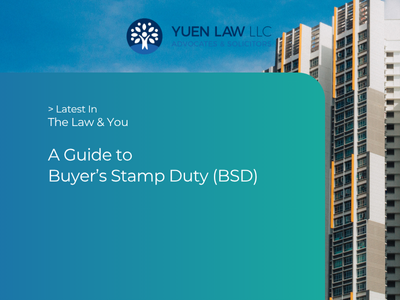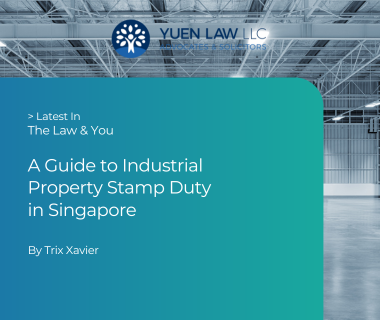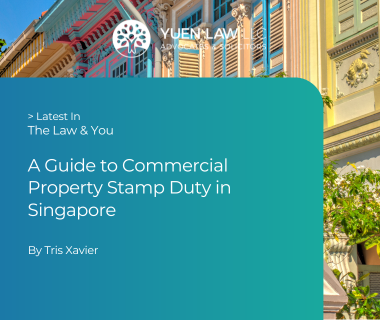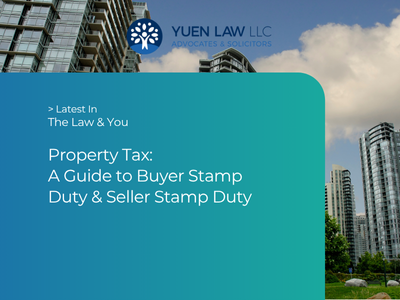Seller Stamp Duty (SSD) is a type of Singapore property tax imposed by Inland Revenue Authority of Singapore (“IRAS”) on property sellers who sell their property within a specified holding period. SSD applies to both residential and non-residential properties.
This article outlines Seller’s Stamp Duty (SSD) in Singapore, covering how SSD is calculated, who it applies to, the current SSD rates for residential and industrial properties, and the latest changes announced in July 2025.
For more details on stamp duty for specific property types, see our related articles on commercial property stamp duty rates and industrial property stamp duty rates.
Seller’s Stamp Duty (SSD) in Singapore
If you’re a seller who acquired a property on or after 20 February 2010, you are required to pay Seller’s Stamp Duty (SSD) if you sell the property within the holding period.
SSD is calculated based on the higher of the purchase price or market value of the property at the time of sale, rounded to the nearest dollar. If different parts of a property were purchased at different times or only part of a property is being sold, SSD is calculated separately for each portion based on its respective holding period.
How to Determine the Holding Period
The holding period is calculated from the date sellers acquired the property, which may refer to any of the following:
- Date of Acceptance of the Option to Purchase (excluding options that are subject to signing of the Sale and Purchase Agreement)
- Date of Sale and Purchase Agreement
- Date of Agreement for Lease (for new HDB flats)
- Date of Transfer (if none of the above apply)
(2025 Updates) Higher SSD Rates and Longer Holding Period
On 3 July 2025, the Government announced changes to SSD rates for residential properties. This will take effect for all residential properties purchased on or after 4 July 2025.
The new measures are in response to a marked increase in private residential property transactions involving short holding periods. Notably, there has been a significant increase in the sub-sale of units that have not been completed.
These changes do not apply to HDB flats, as an existing Minimum Occupation Period (MOP) of five years already restricts resale within that timeframe.
Key revisions are as follows:
- The SSD holding period is increased from three to four years.
- SSD rates are raised by four percentage points for each holding period tier.
Residential Property Seller Stamp Duty Rates
The following tables outline the Seller’s Stamp Duty payable on residential property from 20 February 2010 onwards, including the latest revised rates effective from 4 July 2025.
| Holding Period | Properties acquired between 14 Jan 2011 to 10 Mar 2017 |
Properties acquired between 11 Mar 2017 to 3 Jul 2025 |
Properties acquired on and after 4 Jul 2025 |
|---|---|---|---|
| Up to 1 year | 16% | 12% | 16% (new) |
| More than 1 year and up to 2 years | 12% | 8% | 12% (new) |
| More than 2 years and up to 3 years | 8% | 4% | 8% (new) |
| More than 3 years and up to 4 years | 4% | No SSD Payable | 4% (new) |
| More than 4 years | No SSD payable | No SSD Payable | No SSD payable (no change) |
Table 1a: SSD for residential property from 14 Jan 2011 to present.
14 Jan 2011 to 10 Mar 2017
and up to 3 years
and up to 4 years
Table 1a(i): SSD for residential property acquired between 14 Jan 2011 to 10 Mar 2017.
11 Mar 2017 to 3 Jul 2025
and up to 2 years
and up to 3 years
and up to 4 years
Table 1a(ii): SSD for residential property acquired between 11 Mar 2017 to 3 Jul 2025.
and after 4 Jul 2025
and up to 2 years
and up to 3 years
and up to 4 years
(no change)
Table 1a(iii): SSD for residential property acquired on and after 4 Jul 2025.
| Holding Period | Properties acquired between 20 Feb 2010 and 29 Aug 2010 |
Properties acquired between 30 Aug 2010 and 31 Jan 2011 |
|---|---|---|
| Up to 1 year | 1% on first $180,000 2% on next $180,000 3% on remainder |
1% on first $180,000 2% on next $180,000 3% on remainder |
| More than 1 year and up to 2 years |
No SSD Payable | 0.67% on first $180,000 1.33% on next $180,000 2% on remainder |
| More than 2 years and up to 3 years |
No SSD Payable | 0.33% on first $180,000 0.67% on next $180,000 1% on remainder |
| More than 3 years |
No SSD Payable | No SSD Payable |
Table 1b: SSD for residential property acquired from 20 Feb 2010 to 31 Jan 2011.
|
Properties acquired between 20 Feb 2010 and 29 Aug 2010 |
|
|---|---|
| Holding Period | SSD Rate |
| Up to 1 year |
1% on first $180,000
2% on next $180,000
3% on remainder
|
| More than 1 year and up to 2 years | No SSD Payable |
| More than 2 years and up to 3 years | No SSD Payable |
| More than 3 years | No SSD Payable |
Table 1b(i): SSD for residential property acquired between 20 Feb 2010 and 29 Aug 2010.
|
Properties acquired between 30 Aug 2010 and 31 Jan 2011 |
|
|---|---|
| Holding Period | SSD Rate |
| Up to 1 year |
1% on first $180,000
2% on next $180,000
3% on remainder
|
| More than 1 year and up to 2 years |
0.67% on first $180,000
1.33% on next $180,000
2% on remainder
|
| More than 2 years and up to 3 years |
0.33% on first $180,000
0.67% on next $180,000
1% on remainder
|
| More than 3 years | No SSD Payable |
Table 1b(ii): SSD for residential property acquired between 30 Aug 2010 and 31 Jan 2011.
Frequently Asked Questions on SSD
Am I affected by the new SSD rules?
The revised SSD rates and extended holding period apply only to residential properties purchased on or after 4 July 2025. Under the new rules, the SSD holding period is extended from three to four years before SSD no longer applies.
If you purchased your property between 11 March 2017 and 3 July 2025, the three-year holding period continues to apply.
If you are planning to sell a property, it is important to verify your purchase date to understand which SSD rate applies.
Non-Residential Property Seller Stamp Duty Rates
There is no SSD payable for commercial property. However, as a seller, it’s important to confirm whether your property is classified as commercial or industrial, as SSD applies to industrial property.
Similar to residential property, SSD for industrial property is calculated based on your holding period and is charged on the higher of the sale price or market value, rounded to the nearest dollar.
| Holding Period | SSD Rate |
|---|---|
| Up to 1 year | 15% |
| More than 1 year and up to 2 years | 10% |
| More than 2 years and up to 3 years | 5% |
| More than 3 years | No SSD payable |
Table 2: SSD rates for industrial property.
Seller’s Stamp Duty Calculator
Inland Authority Revenue of Singapore (IRAS) provides a free Stamp Duty Fee Calculator.
If you are a seller looking to sell property and require assistance with Seller’s Stamp Duty, contact us to make an appointment.




